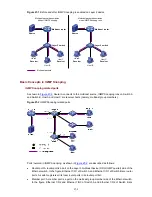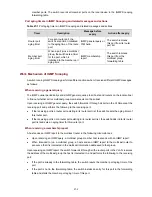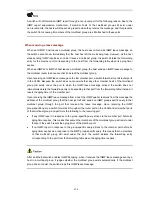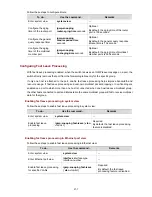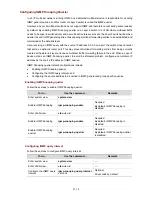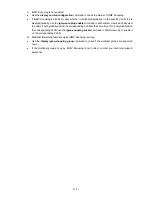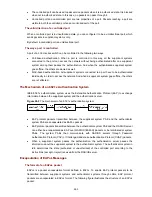
27-9
z
A port can belong to multiple VLANs, you can configure only one ACL rule per VLAN on a port.
z
If no ACL rule is configured, all the multicast groups will be filtered.
z
Since most devices broadcast unknown multicast packets by default, this function is often used
together with the function of dropping unknown multicast packets to prevent multicast streams from
being broadcast as unknown multicast packets to a port blocked by this function.
z
The configuration performed in system view takes effect on all ports of the switch if no VLAN is
specified; if one or more VLANs are specified, the configuration takes effect on all ports in the
specified VLAN(s).
z
The configuration performed in Ethernet port view takes effect on the port no matter which VLAN it
belongs to if no VLAN is specified; if one or more VLANs are specified, the configuration takes
effect on the port only if the port belongs to the specified VLAN(s).
Configuring the Maximum Number of Multicast Groups on a Port
By configuring the maximum number of multicast groups that can be joined on a port, you can limit the
number of multicast programs on-demand available to users, thus to regulate traffic on the port.
Follow these steps to configure the maximum number of multicast groups on a port:
To do...
Use the command...
Remarks
Enter system view
system-view
—
Enter Ethernet port view
interface interface-type
interface-number
—
Limit the number of multicast
groups on a port
igmp-snooping group-limit
limit
[
vlan
vlan
-
list
[
overflow-replace
] ]
Required
The maximum number of
multicast groups on a port is
256 by default.
z
To prevent bursting traffic in the network or performance deterioration of the device caused by
excessive multicast groups, you can set the maximum number of multicast groups that the switch
should process.
z
When the number of multicast groups exceeds the configured limit, the switch removes its
multicast forwarding entries starting from the oldest one. In this case, the multicast packets for the
removed multicast group(s) will be flooded in the VLAN as unknown multicast packets. As a result,
non-member ports can receive multicast packets within a period of time. To avoid this from
happening, enable the function of dropping unknown multicast packets.
z
If an Ethernet port is a static member port for a multicast group, the configuration of the maximum
number of multicast groups that can be joined does not take effect on the port.








